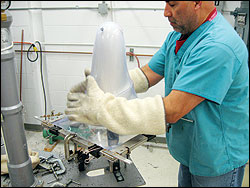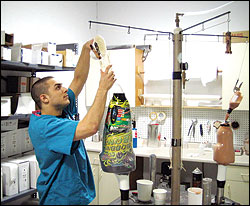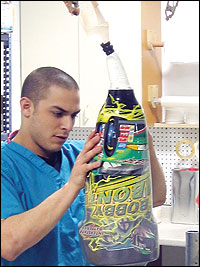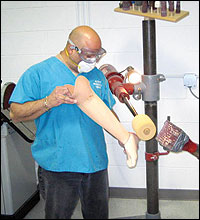As a boater and sports fisherman, I have learned many different ways to chart a course. Once you know your starting and ending points, you can determine the best route to your destination. The journey may not always be easy. You may encounter obstacles, such as shallows, tide changes, and navigational hazards. Therefore, you need to follow a defined course. To learn successful charting, you can take courses on navigation, or you can learn as you go. Having a good reference book on hand is always a good idea. Almost every boater’s library, for example, contains a copy of Chapman Piloting: Seamanship & Small Boat Handling, by Elbert S. Maloney.
How is this related to orthotic and prosthetic fabrication? When looking to enter the O&P profession as an orthotic or prosthetic technician, individuals can choose to attend a formal technical education program or acquire a position where they will be trained by their employer, learning as they go. Although the various schools may have their own manuals, I do not know of a reference book that is dedicated to fabrication. The training and development of current and future O&P technicians needs a definite course to follow. The development of a technical reference book or manual would also be a great addition to our profession.
Evolving Care Model
This fall will mark my 40th year in the O&P profession. I was fortunate to have had a high school counselor who took an interest in his students. This gentleman listened to my academic and personal interests when guiding me. As a kid who built models and as a teenager who spent a summer restoring a small runabout boat, when my first job out of high school was entering what was then called a “shop,” it was like a dream come true (although I must admit that I don’t miss making PVA bags). This is still how most individuals enter our field as technicians, learning as they go. One major difference from then to now is the patient care delivery model. Forty years ago, most technicians were also fitters and care providers. Technicians provided all aspects of care: evaluation, design, fitting, fabrication, adjustments, and repairs. There was no delegation of processes-technicians did it all. But in retrospect, patient care was much less technical, prosthetic component choices were much simpler, suspension methods were not as complex, and no one knew what a microprocessor was. Orthotic devices were all metal and leather with various joint variations. Plastics for orthotics started to be used by our profession in the late 1970s and early 1980s. Like microprocessors, no one had ever heard of tone reducing or functional electrical stimulation.

Today, the O&P profession is far more complex. Educational programs have developed to the point where a practitioner will need to complete a master’s-level degree program to be board eligible. This is a necessary part of keeping up with technological advancements as well as preventing other allied healthcare disciplines with similar education requirements from encroaching on our profession.
The O&P patient care delivery model continues to evolve. In the emerging tiered model, practitioners will have little or no technical skills; their training will be much more clinical and scientific. O&P practitioners will be responsible for developing a patient treatment plan in conjunction with the patient’s other healthcare providers. These practitioners will be creating prescription criteria, establishing outcome goals, and overseeing the delivery of and follow-up care for orthotic and prosthetic services. A certified assistant will most likely do the actual casting, fitting, and servicing of a device, and fabrication will be performed by an in-house lab, or it will be outsourced to a central fabrication facility.
This treatment method is commonly referred to as the care-extender model. Changes in the healthcare delivery system are making this model necessary. As reimbursements continue to shrink and services provided are more controlled, practitioners will need to see more patients. Since our patient care model requires that we spend ample time with the patient, that care must be delegated to an assistant in order to increase the number of patients treated. Although I’ve presented this as a futuristic model, the O&P profession already has centers that function successfully with this delivery methodology.
Rebuilding Our Foundation

As a practitioner who started on the bench, became a CPO, and is now once again active on the technical side, I see one major, foundational ingredient missing: fabrication. Brad Mattear, MA, CFo, general manager of O&P1, Waterloo, Iowa, is on the board of various National Commission on Orthotic & Prosthetic Education (NCOPE)-approved technical schools. In the article, “Technician Education-Filling in the Gaps” (The O&P EDGE, July 2009), Mattear commented that our technicians are still being taught the same material in the same way they were taught 20-30 years ago. I agree wholeheartedly. I am very glad, however, that our professional associations have adopted the Standards and Guidelines for the Accreditation of Educational Programs in Orthotic and Prosthetic Technology. These guidelines address current issues and trends in fabrication. With these standards, future technical students will be exposed to newer concepts in design and fabrication. More state-of-the art prosthetic socket designs and suspension methods, such as elevated vacuum, will be discussed. Current trends in orthotic design will be covered as well. Students will be briefed in the use of CAD/CAM for orthotic and prosthetic design as well as mold creation. Given the vast amount of skills needed to fabricate all the various types of devices we provide, no one expects students to graduate knowing them all. Our hope is that they graduate with a foundation in which to enter the technical side of our profession and that they acquire a position that will allow them to continue learning and growing. Because technical skills are becoming a smaller part of the curricula for practitioner and assistant education and training, technicians will be an increasingly important part of our patients’ care. I do believe, however, that practitioners and assistants need to have some understanding of fabrication.

An analogy I like to use is that of a future homeowner. When future homeowners acquire a piece of property to build a house on, they see land with some trees. When architects look at the land, they see the house, landscaping, and kids playing in the yard. Although the architects will not be the ones actually building the house, they understand the mechanics of it and know what can and cannot be done. I see future O&P practitioners as being similar to architects. They can see their patients’ devices in their minds’ eye, doing what they intend it to do. In order to do this, they will need technical knowledge. Although practitioners will not need to know enough to actually fabricate devices, they should at least have a working knowledge of what is required. All too often, fabricators are asked to perform impossible technical tasks or meet unrealistic delivery goals. This is largely due to practitioners’ lack of technical knowledge about the device they are providing. We have had to contact a practitioner on many occasions to let them know that the components they selected will not fit into the length restrictions or that the patient’s weight class is conflicting. This lack of knowledge can cause problems between the technician and practitioner, or worse, between the practitioner and the patient. The patient is often the one whose hopes are shattered or delivery expectations are not met. Better technical training would help to prevent these types of problems from occurring.
Charting Our Course

Support authors and subscribe to content
This is premium stuff. Subscribe to read the entire article.




